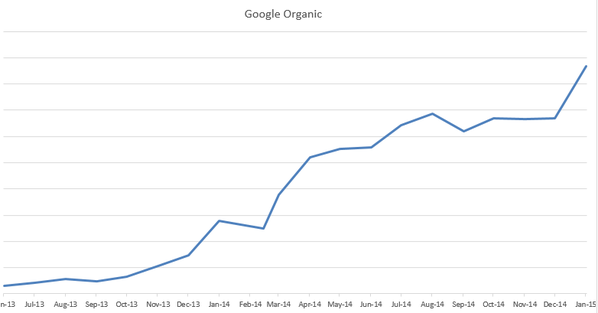
GSD
Blog Subdomain or Subdirectory? Hint: One is 40% Better
Posted by Jake Lumetta on September 16, 2023
In today’s increasingly connected world, your business’ website plays an enormous role in the success of your company, especially if you plan to use inbound marketing tactics to drive traffic to your site organically.
To this end, it’s critical that you do your due diligence when deciding what the architecture of your site should look like.
Blogging, in particular, can have a huge impact on a business’ performance. So it comes as no surprise that one of the most asked questions in the world of blog SEO is "Should I host my blog at blog.example.com or www.example.com/blog?"
If you search around online, you'll find a lot of people voicing opinions. Despite this, the conclusion is still quite subjective. Some argue it depends on the business use case. But if your primary concern is having people find your content when searching (i.e., SEO) then the data points to a clear winner.
Subdomains vs. subdirectories: What’s the difference?
They sound fairly similar and look pretty similar.
But what exactly are the differences between subdomains and subdirectories?
Subdomain example
A subdomain is a URL that allows you to essentially create several websites on a single domain. It’s the store.yourcompany.com kind of URL.
Popular use cases for subdomains include staging versions of a website, testing new plugins and integrations, creating ecommerce stores, and hosting mobile sites (e.g., m.youtube.com).
Beyond that subdomains can make it easier to organize website content on larger sites, target specific segments of your market, and enhance SEO rankings when used correctly. (When used incorrectly, however, subdomains can crush SEO).
Subdirectory example
Subdirectories, on the other hand, are URLs that host subsets of content in separate “folders.” It’s the yourcompany.com/store kind of URL.
Popular use cases for subdirectories include:
- optimizing existing websites,
- increasing SEO traffic to your main domain,
- organizing content in a way that’s easy to understand and manage,
- and streamlining analytics by housing data on one standalone domain instead of potentially several subdomains, which could make data analysis harder.
Are subdomains or subdirectories better for SEO?
Google says that they treat traffic to subdomains and subdirectories exactly the same.
Making changes to site structures, however, may influence search traffic on a temporary basis until things settle, according to Google. So whichever route you ultimately decide to take, you should stick to it.
But not everyone agrees.
Subdomains might work perfectly fine for an industry juggernaut like Disney that has many different areas of operations that folks are interested in (e.g., movies, theme parks, and merchandise).
Because lots of traffic is being driven to each of the company’s subdomains, their overall SEO for each site is (unsurprisingly) performing quite well.
Of course, most people don’t have the same resources or highly engaged audiences as Disney.
If your business is like most others, you probably focus on a more narrow niche. A content marketing company might post about blogging tips and a cryptocurrency startup might post about the merits of decentralization and smart contracts, for example.
If your focus is more narrow, you may benefit from using subdirectories because they will improve your overall SEO traffic to your main domain, and that should probably be your goal.
Why is blog.example.com subdomain so popular?
Historically the most common reason for companies to host their blog on blog.example.com is due to technical reasons. Throwing your blog on a subdomain is the easiest route when setting up a third-party blog like WordPress, Tumblr, and Squarespace.
Achieving www.example.com/blog has historically been surprisingly difficult. In the case of WordPress, for example, your engineering team is forced to self-host your site if you want that URL. Ask any engineer or DevOps programmer and they'll tell you this has huge security and maintenance implications.
So instead of going through that hassle, the default choice is to just go with blog.example.com because it's easiest, not because it's best for SEO.
Butter solves this issue for you (more on that later). But first, let's look at some examples of what companies have experienced using subdomains and subdirectories.
What others have seen
A major source of confusion in the debate stems from this video put out by Matt Cutts at Google. The message is seemingly clear, yet still somewhat [intentionally] vague.
I'm sure Matt would agree with a more data driven approach to testing what the truth is, so let's get to it.
We've pulled together 5 different data points from results other companies have seen when experimenting with their own blog and domain configurations.
PinkCakeBox
PinkCakeBox reports they saw a 40% boost in organic traffic by moving their blog to a subdirectory.
HotPads
While they don't disclose their exact numbers, HotPads saw a very clear hockey stick type growth in their organic traffic from Google.
World First
Martin Pezet, an in-house SEO expert at World First, shared his traffic graph after moving to a subdirectory. Again, it’s up and to the right.
IWantMyName
The last data point is from IWantMyName. They actually did a reverse experiment where they moved from a subdirectory to a subdomain. What happened? A 47% drop in organic traffic. Ouch!
Setting up subdomains and subdirectories
Imagine you’ve decided to launch or relaunch a website. After buying your domain, it’s time to figure out whether to go the subdirectory or subdomain route when you go about setting up your blog.
Not super confident in your ability to add a blog to your site in the first place? Use a tool like Butter to save time and money while expediting the development process. With Butter, you’ll be writing content that delights your customers in no time while increasing your organic SEO reach.
Based on the data, we think the subdirectory approach is probably the best for most businesses. Unless you’re planning to run a part of your website on a separate server, a subdirectory will help you keep your content organized while improving SEO rankings and simplifying website management.
Of course, if you have enormous plans for your company, the subdomain route might be optimal, too. But subdirectories are probably the better choice for the average company.
If you’ve already launched a website with subdomains but want to migrate to subdirectories, that process doesn’t have to be as difficult as it may sound.
The bottom line: You know your business better than anyone else. Spend some time thinking about what you hope the future looks like and use those ideas to inform the development of your website architecture.
Worried that the challenge ahead is a big one? With the right tools in place, it doesn’t necessarily have to be.
Butter for the SEO win
We've built Butter for many reasons, one being optimal SEO and getting the most out of your content. Butter makes achieving your blog at www.example.com/blog impressively simple. (Looking to get the most out of your content on Wordpress, with more flexibility and control over your content display and distribution?)
It does this through magical plugins that integrate into your existing website application. The result is a blog with the URL of www.yoursite.com/blog and blog posts with URLs featuring SEO-friendly slugs like www.yoursite.com/blog/my-fancy-blog-post.
Have you experimented with subdomain vs. subdirectory? If so, we'd love to hear your experience in the comments below.
Here’s to happy blogging and ever-improving SEO rankings!
ButterCMS is the #1 rated Headless CMS
Related articles
Don’t miss a single post
Get our latest articles, stay updated!




















Jake is the CEO of ButterCMS. He loves whipping up Butter puns and building tools that make developers' lives better.